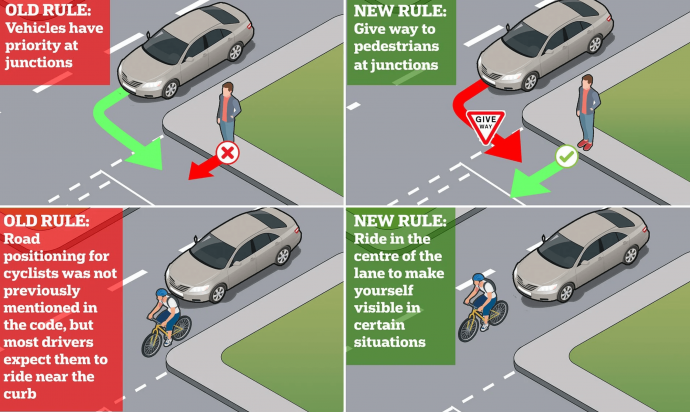
The Highway Code will later this month for the first time introduce a hierarchy of responsibility to British roads. The change requires those who could cause the greatest harm to bear the greatest responsibility of reducing danger on the road. This long-overdue does of commonsense means there will exist a legal hierarchy of road users. The concept places vulnerable road users most at risk in the event of a collision at the top of the hierarchy as follows:
- Pedestrians
- Cyclists
- Horse riders
- Motorcyclists
- Cars/taxis
- Vans/minibuses
- Large passenger vehicles/heavy goods vehicles
Pedestrians are at the top of the pyramid because they pose the least risk to others whereas heavy goods vehicles have the potential to do the greatest harm. The concept of there being a hierarchy of road users is one of a number of changes intended to make our roads safer for vulnerable road users.
For example, new rules will also mean pedestrians will take priority when waiting to cross a road vehicles are turning into and cyclists will be given priority over vehicles in some aspects.

The Highway Code is a mixture of legal requirements – to disobey these ‘must’ rules is a criminal offence. This month’s changes introduce new advisory ‘should’ measures that while not legal requirements, will be drawn upon when road users find themselves in court.
The changes to the Highway Code include advice that drivers:
- Should give way to pedestrians crossing or waiting to cross a road into which or from which their vehicle is turning.
- Should not cut across cyclists or horse riders going ahead when turning into or out of a junction or changing direction or lane.
- Should open car doors with the hand on the opposite side to the door they are opening. This makes drivers turn their heads to look over their shoulders and makes it more likely they’ll spot an approaching cyclist
- Should leave at least 1.5 metres when overtaking cyclists at speeds of up to 30mph, and give them more space when overtaking at higher speeds.
The code also advises cyclists to give way to pedestrians on shared-use cycle tracks and to “slow down when necessary and let them know you are there, for example by ringing your bell (it is recommended that a bell is fitted to your bike) or by calling out politely.”
The ethical choice
The ETA was established in 1990 as an ethical provider of green, reliable travel services. Over 30 years on, we continue to offer cycle insurance (covers cargo bikes), breakdown cover and mobility scooter insurance while putting concern for the environment at the heart of all we do.
The Good Shopping Guide judges us to be the UK’s most ethical provider.
Peter Kinnear
Re cyclists and pedestrians on shared space–
Many cyclists don’t ring their bell when coming up from behind; some don’t even have a bell! I’m hard of hearing, which doesn’t help, but cyclists with a decent bell I can hear. I’ve been in several ‘near misses’ when someone has passed me very, very close, at speed; it’s quite frightening. In my seventies, a nasty accident could be serious.
When using shared space, please think about ‘clear passing’– for pedestrians!
Vincent Edwards
I agree with everything you say. But you may not be aware that some pedestrians become extremely abusive and even aggressive when a cyclist rings the bell – some appear to take it as a personal insult. There’s no right answer here for every situation.
Joel
On an old bike I had a bell and when I used it pedestrians would jump out if their skin because it gives no indication of the scale, imminence and likelihood of danger. Luckily words and the human voice can communicate all these things – I find clear communication of what I’m going to do and/or what they can do to avoid an accident works best.
Norman Murray
A lot of these changes are going to prove more dangerous to pedestrians, horse riders and drivers, what clown thought these rules up, he should be sacked on the spot.
Rona Wightman
Diagram is incorrect. Drivers do not currently have priority at junctions, no one does. Generally pedestrians choose to yield.
The ETA
The diagram you’re suggesting is wrong is taken directly from the Highway Code